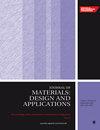Obtaining the effective number of reinforcements progressively inserted and optimized to reduce the strain energy of cantilever plates with a different relationship between height and length
IF 2.5
4区 材料科学
Q3 MATERIALS SCIENCE, MULTIDISCIPLINARY
Proceedings of the Institution of Mechanical Engineers, Part L: Journal of Materials: Design and Applications
Pub Date : 2024-05-20
DOI:10.1177/14644207241255374
引用次数: 0
Abstract
To achieve more efficient structures, research into material properties is important in mechanical designs. The anisotropy of fiber composites is increasingly being exploited. This is particularly true for curved and continuous composites. The position and orientation of the filaments have a major influence on mechanical properties. So, the application of these fibers at specific paths is very important to obtain excellent structures. When developing components for high-performance applications, it is necessary to use optimization methods to find the best reinforcement paths. To achieve high efficiency, it is necessary to reduce the volume of the reinforcements to improve the strength-to-weight ratio. This reduction not only directly reduces the mass, but also decreases manufacturing costs. The present work aims to gradually add reinforcements to carbon fiber-reinforced polymers (CFRPs). It observes the exact number of fibers required to achieve the greatest possible reduction in strain energy. The results prove that the use of more reinforcements than ideal is unnecessary because it increases the volume of reinforcements but doesn’t improve the properties. Optimization is achieved by parameterizing B-splines using sequential linear programming (SLP). Four cases analyzed concern a cantilevered plate. A force is applied to the free edge, causing bending. The boundary conditions are identical, and only the length of the plate changes. The strain is plotted to observe the strain distribution. Then, the results show that adding three to four reinforcements can reduce the strain energy by 92.6% to 98.0% compared to a structure without reinforcements.获得逐步插入和优化的有效钢筋数量,以降低高度和长度关系不同的悬臂板的应变能
为了实现更高效的结构,对材料特性的研究在机械设计中非常重要。纤维复合材料的各向异性正越来越多地被利用。对于弯曲和连续的复合材料来说尤其如此。纤维丝的位置和取向对机械性能有重大影响。因此,在特定路径上应用这些纤维对于获得优异的结构非常重要。在开发高性能应用部件时,有必要使用优化方法来找到最佳的加固路径。为了实现高效率,有必要减少增强材料的体积,以提高强度重量比。这种减少不仅能直接减轻质量,还能降低制造成本。本研究旨在逐步向碳纤维增强聚合物(CFRP)中添加增强材料。它观察了实现应变能最大可能的减少所需的确切纤维数量。结果证明,使用比理想数量更多的增强材料是不必要的,因为这会增加增强材料的体积,但不会改善其性能。通过使用连续线性规划(SLP)对 B-样条线进行参数化,实现了优化。分析的四个案例涉及悬臂板。自由边缘受力,导致弯曲。边界条件相同,只有板的长度发生变化。绘制应变图以观察应变分布。结果表明,与没有加固的结构相比,添加三到四个加固件可将应变能降低 92.6% 至 98.0%。
本文章由计算机程序翻译,如有差异,请以英文原文为准。
求助全文
约1分钟内获得全文
求助全文
来源期刊

CiteScore
4.70
自引率
8.30%
发文量
166
审稿时长
3 months
期刊介绍:
The Journal of Materials: Design and Applications covers the usage and design of materials for application in an engineering context. The materials covered include metals, ceramics, and composites, as well as engineering polymers.
"The Journal of Materials Design and Applications is dedicated to publishing papers of the highest quality, in a timely fashion, covering a variety of important areas in materials technology. The Journal''s publishers have a wealth of publishing expertise and ensure that authors are given exemplary service. Every attention is given to publishing the papers as quickly as possible. The Journal has an excellent international reputation, with a corresponding international Editorial Board from a large number of different materials areas and disciplines advising the Editor." Professor Bill Banks - University of Strathclyde, UK
This journal is a member of the Committee on Publication Ethics (COPE).
 求助内容:
求助内容: 应助结果提醒方式:
应助结果提醒方式:


